With a growing user base of 650 million users, Apple Search Ads lets you run profitable app campaigns to drive impressions and downloads. You can run targeted campaigns and reach the intended audience with intuitive campaign management and multiple ad placements. While you can access native analytics through Apple Search Ads dashboards, it can become complex to visualize the results of multiple app campaigns holistically.
With the Apple Search Ads Connector from Two Minute Reports, you can easily connect your Apple Search Ads account to Google Sheets. TMR will pull real-time app campaign metrics, extract insights, and let you create custom reports without any hassle. Our setup ensures data security through encryption and storing data in your private Google Sheets.
Now, let me explain how to connect Apple Search Ads data via Two Minute Reports to Google Sheets.
Step 1: Install and Launch Two Minute Reports
Install Two Minute Reports if you have not done so already.
Sign in to your Google Sheets with the associated Gmail ID.
Go to Extensions > Add-ons > Get add-ons.
Search for Two Minute Reports and select Install.
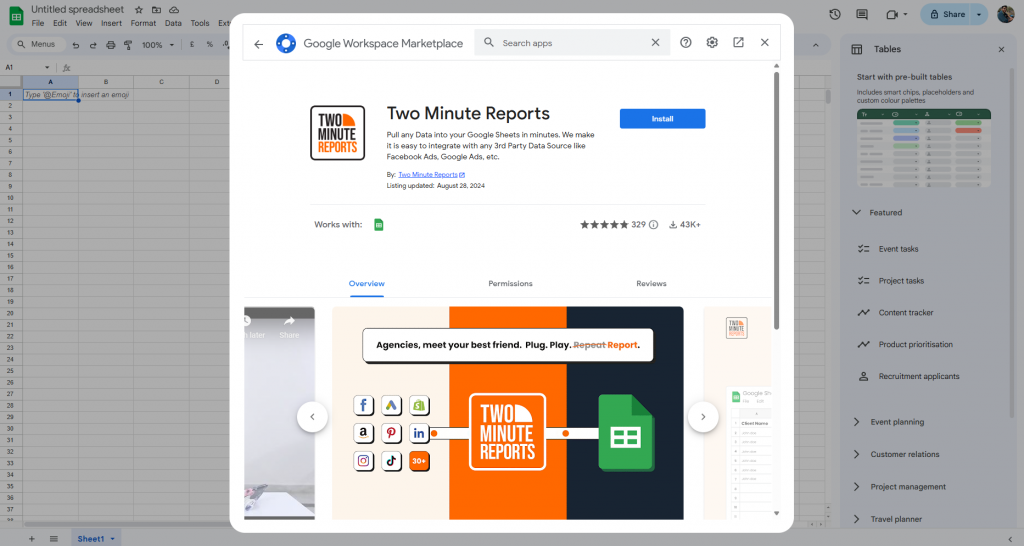
Review and accept the permissions necessary to run Two Minute Reports. Once you’ve accepted the terms and conditions, click Allow for Two Minute Reports to manage and access your data.
Note: Allow access is mandatory for TMR to function and efficiently analyze your data.
Next, open your Google Sheets and go to Extensions > Two Minute Reports > Launch.
Once your TMR sidebar opens, you can connect your data sources and run queries.
Step 2: Connect Apple Search Ads to Google Sheets
Click Menu at the top left of the sidebar to navigate to the Data Sources section. If you see an onboarding popup, please proceed with it or minimize it by clicking the inverted arrow.
Click Add, name your data source, and select your data source type as Apple Search Ads from the Advertising dropdown.
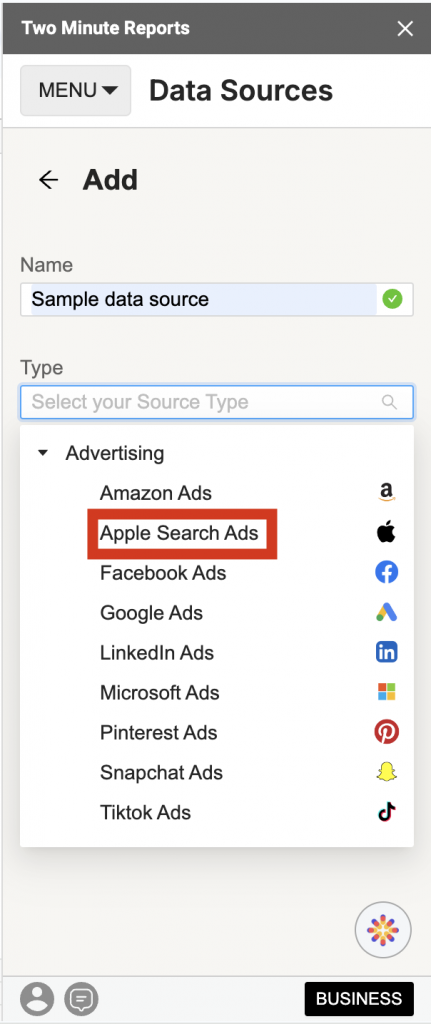
Once you select the data source, you’ll be presented with the following fields: Public Key, Client ID, Team ID and Key ID.
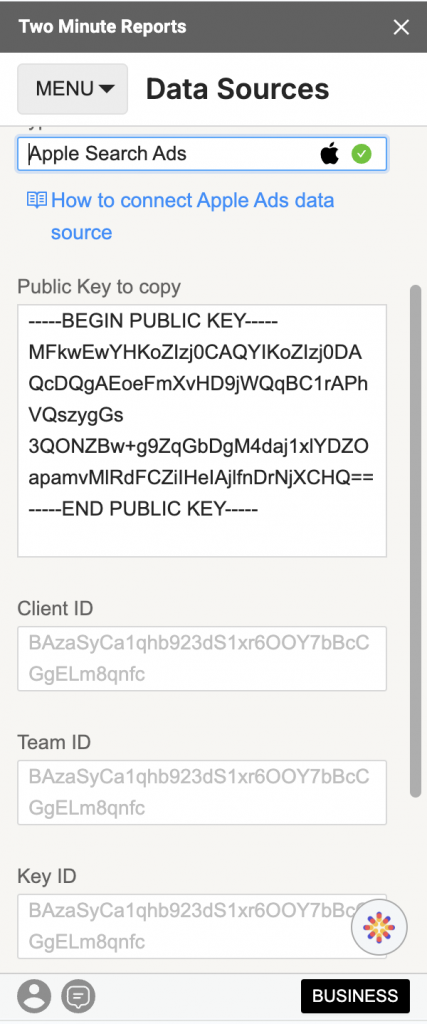
In the upcoming steps, we’ll get to know how to generate the Client ID, Team ID and the Key ID.
Step 3: Generate API credentials from your Apple Search Ads dashboard
To generate API credentials from the Apple Search Ads dashboard, you need to have accounts with an API Account Manager or API Account Read Only user roles. If you have an Account Admin user role, you won’t be able to generate them.
If you don’t have an account with the above-mentioned user role, you can login to your Admin role account and follow the below steps to send the invite.
Here are the steps to invite a user with the appropriate access:
- Log in to your Apple Search Ads dashboard with your Account Admin role account.
- Click on your account name in the dashboard’s top right section and select the Settings option next to it.
- Go to the User Management tab.
- Click on Invite User.
- Provide the name and Apple ID of the person you want to share your account with.
- Select User Access and Role as API Account Manager or API Account Read Only, then click “Send Invite.”
- The invitee will receive an email explaining that they’ve been invited to an Apple Search Ads account. Accept the invite to get access.
Note: If the invited user does not have an Apple Search Ads account, they must complete the signup process while accepting the invite.
Once you’re done with the above steps, navigate to your Apple Search Ads dashboard, click Sign In, and choose the Advanced option.
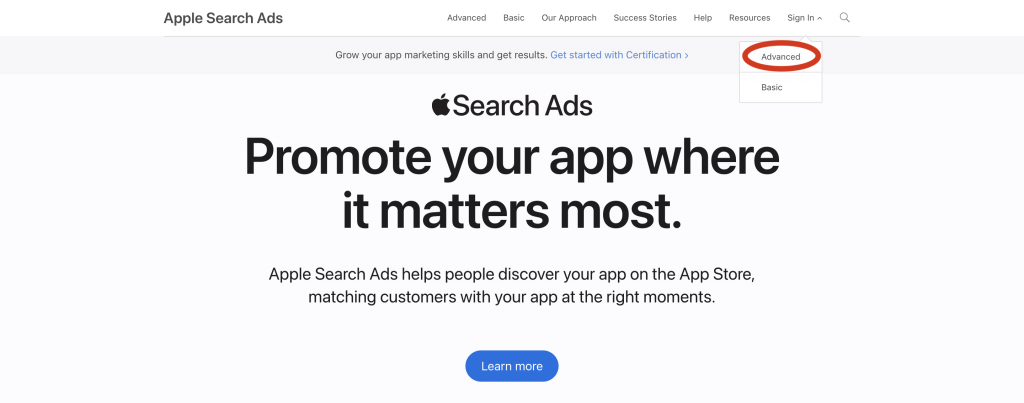
Next, sign in to your Apple Search Ads account with API Account Manager or API Account Read Only user role. Enter your Apple ID and password and click the arrow icon to log in.
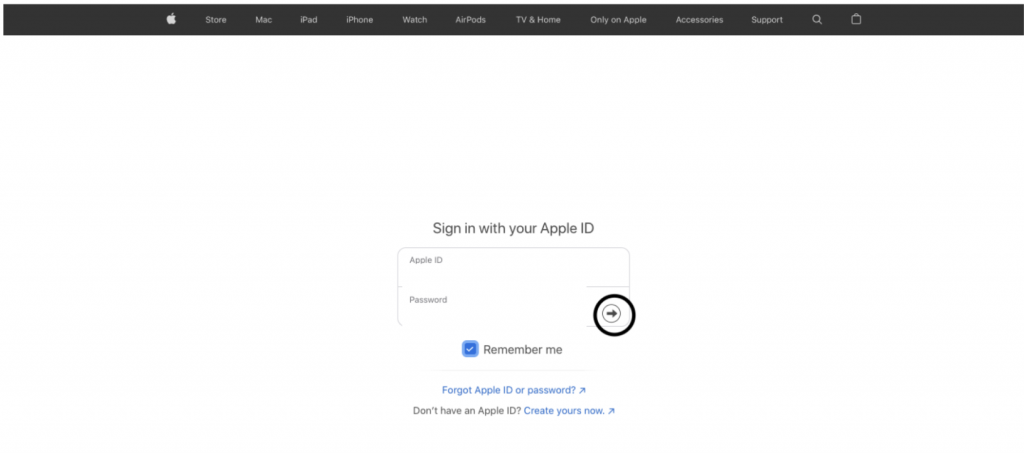
You will be directed to the Apple Search Ads campaign dashboard once you log in with your account.
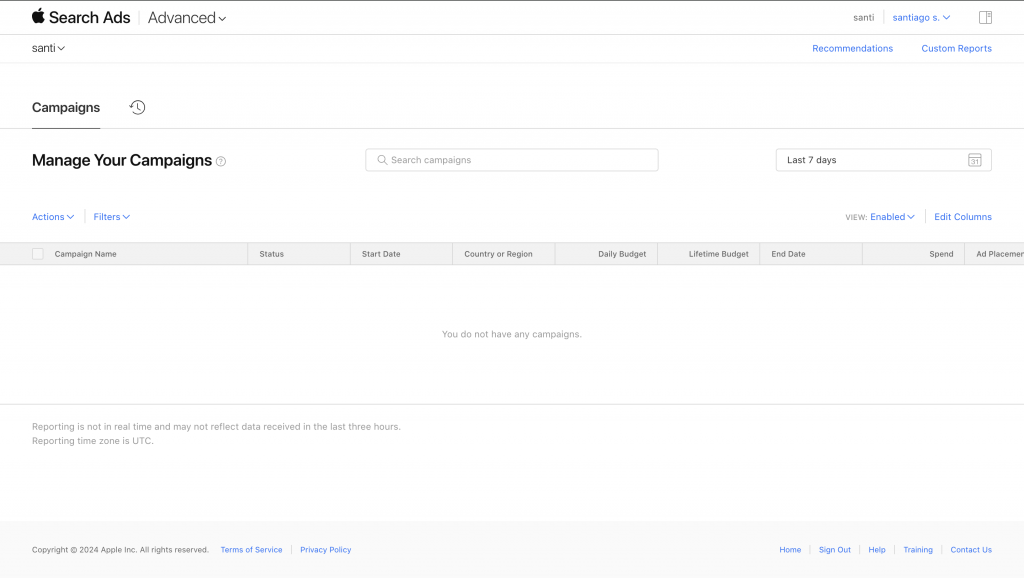
Now, click on your Account Name on the top right section and select the Settings option next to your account name.
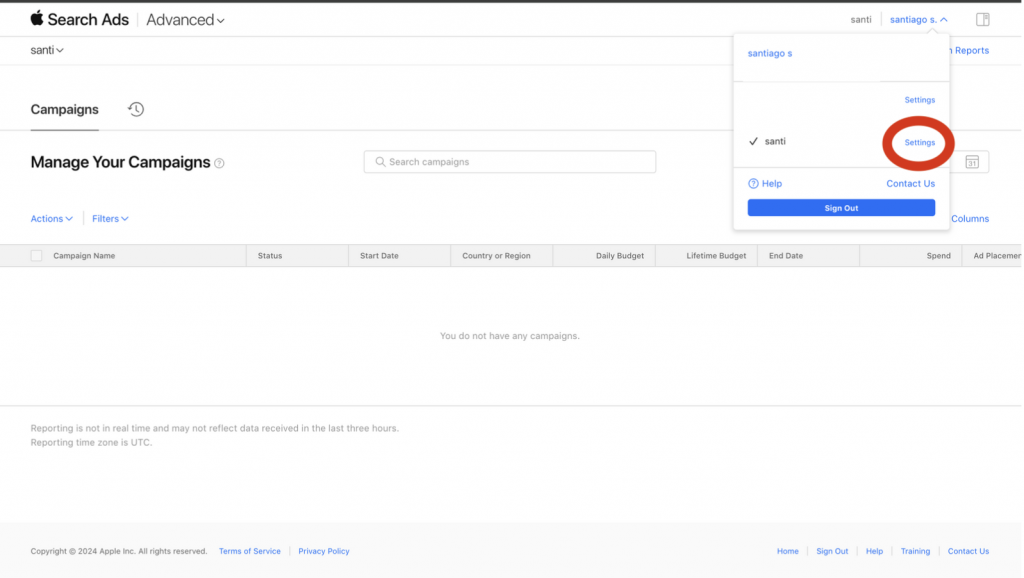
You will now be taken to the API Credentials page.
Copy the Public Key from the Two Minute Reports sidebar (from Step 2), paste it into the Public Key of the Apple Search Ads dashboard, and click Save.
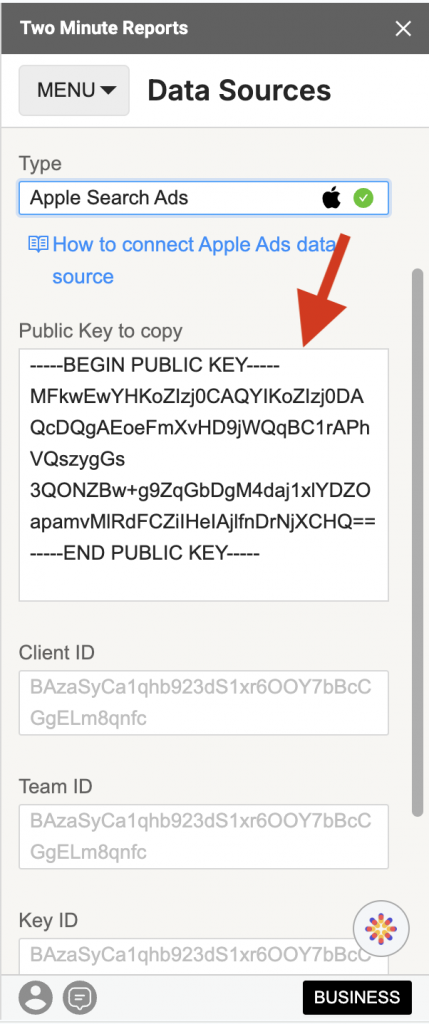
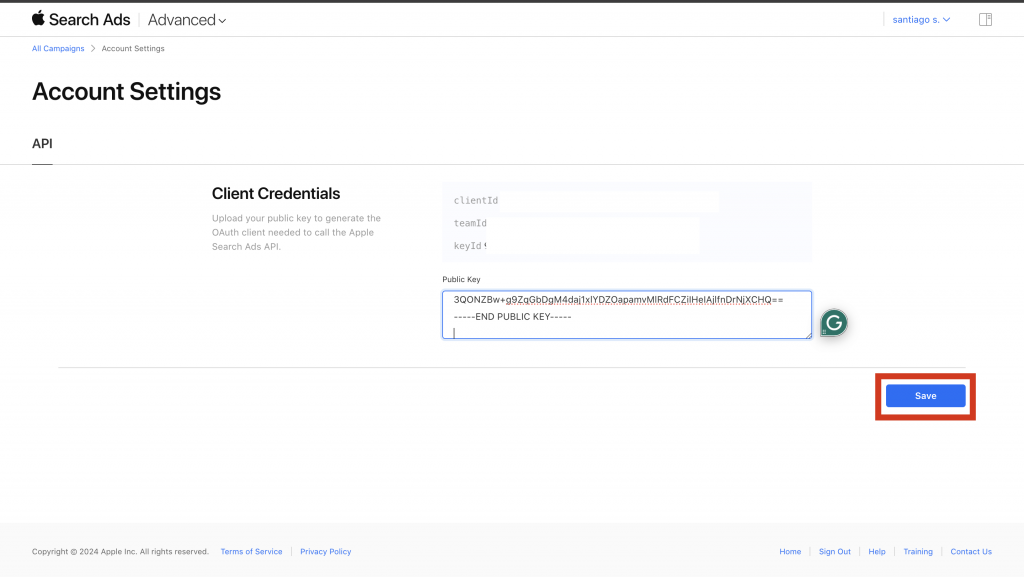
Note: Copy the entire public key, including BEGIN PUBLIC KEY and END PUBLIC KEY from the TMR sidebar to paste into the Apple Search Ads dashboard. The pasted public key should have a line break at the end to ensure error-free account authentication. Also, if you have a fresh Apple Search Ads account (client ID, team ID, and key ID being empty), the Save option will be replaced with “Generate API Client”.
Once you click Save, the client ID, team ID, and key ID will be generated.
Copy the client ID, team ID, and key ID. Next, navigate to the TMR sidebar and paste them into the respective fields.
Click Test Connection. Once the connection is successful, click Yes to save the configuration and proceed.
Step 4: Getting Apple Search Ads data in Google Sheets
To pull the Apple Search Ads performance data, you must first create a new query by navigating to the Data Queries section.
Click Add and choose the Apple Search Ads account to analyze its campaign data. You can manage multiple clients’ Apple Search Ads under one roof. Simply select one or multiple ad accounts to analyze performance.
Alternatively, you can navigate to the Clients section. Add your client and map their corresponding Apple Ad account.
Click on “Manage Clients” and enter the necessary account details. Once done, click “Save & Close” to save your client’s details for future reference.
Note: You can add multiple clients and map their respective ad accounts. Doing so saves you tons of wasted hours from manually juggling numerous data sets. You can get a unified view of your client campaigns and track crucial metrics in a centralized dashboard. For further information, please read our guide – “How to create queries using Accounts” and “How to create queries using Clients.”
Next, add the Apple Search Ads metrics and dimensions you want to analyze. You can choose from the list of metrics and dimensions to assess your Apple Search Ads campaign performance. Refer to the screenshot below for better understanding.
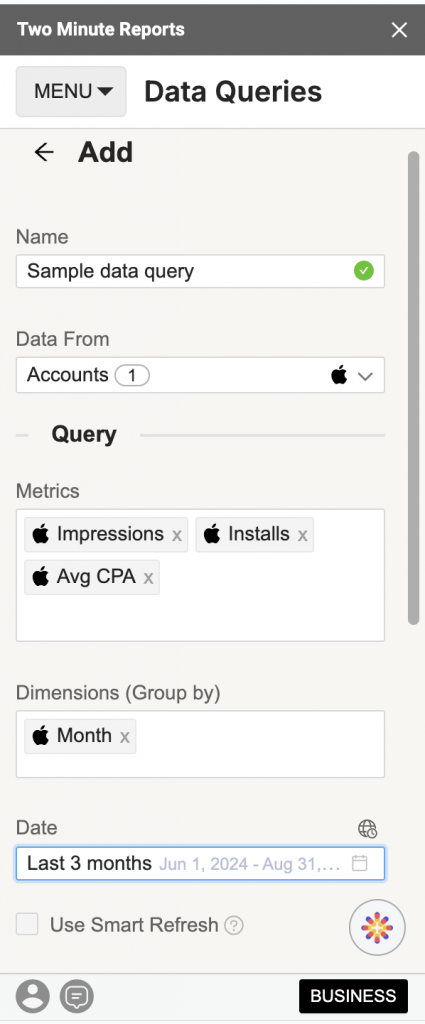
Next, you have to configure your data reporting by choosing how to customize it.
It would be best to customize your data reporting by selecting the relevant fields and choosing whether to sort them in ascending or descending order. You can also apply custom filters to display only the necessary information.
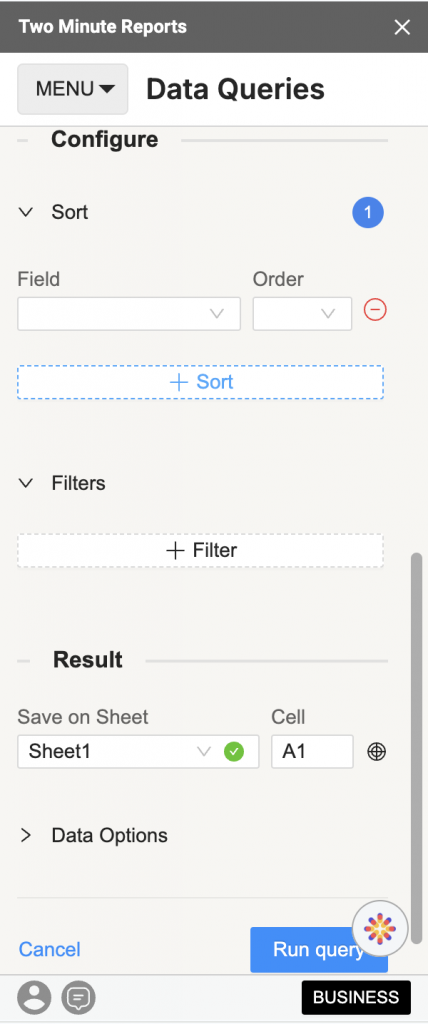
Once you have completed the above steps, click Run Query to visualize the final output.
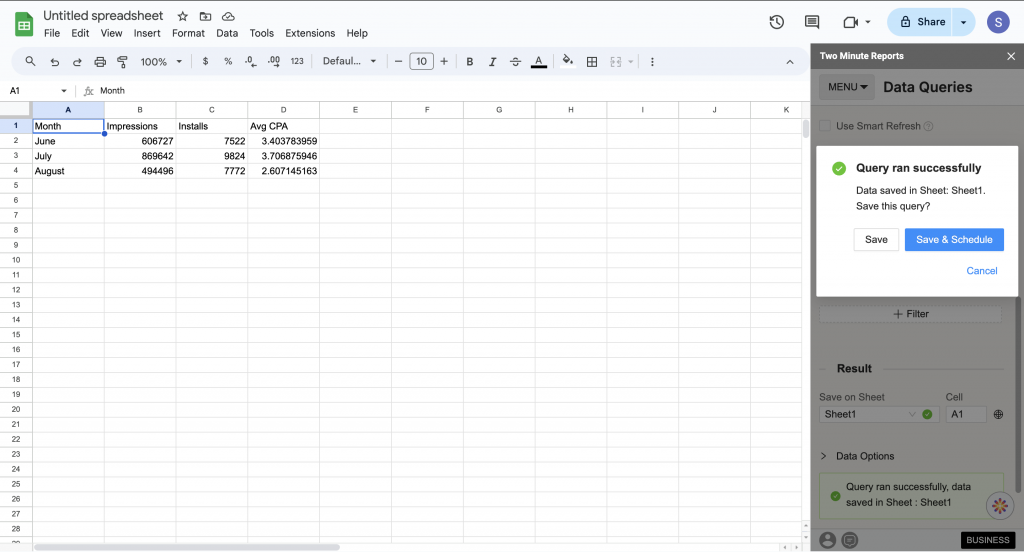
Now, you can use different Google Sheet features, such as pivot tables and VLOOKUP(), to extract critical insights and build charts to elevate your reporting.
Pro TMR Tip: Run all your queries directly from the Extensions menu on your Google Sheets. Go to Extensions > Two Minute Reports > choose your desired quick action.
Step 5: (Optional) Get automatic updates via Schedule Refresh
Once you create a report in Google Sheets, you can schedule automatic updates to get updated data. This feature is convenient for sending emails or refreshing your spreadsheets with live data and using them as a dashboard.
Under the email section, you can enter the recipient(s)’s email ID and save the new schedule.
You can also choose to specify the reporting format. You can insert the sheet content in the email body, attach the selected sheet as a PDF or Excel, or attach the spreadsheet as an Excel file.
Two Minute Reports’s schedule refresh or data refresh feature has other capabilities. For more information, please read our guide, “How to Refresh Data Automatically in Google Sheets.”
We hope you found this guide helpful. Please contact our support team via chat or [email protected] if you have any questions.